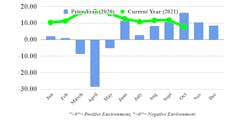FTR’s Trucking Conditions Index (TCI) measure for October fell to a reading of 7.75—the weakest reading since July 2020—because of a surge in diesel prices.
Had fuel prices been a neutral factor, FTR said, the change in the index from September’s 11.79 reading would have been negligible. Freight rates remain the largest positive factor, although they were modestly less positive in October. However, freight volume and utilization were stronger positive factors than they had been in September. Fuel costs have now stabilized, and the TCI outlook is for solidly positive readings well into 2022.
“October was an outlier due to the brief surge in diesel prices, but conditions in 2022 are unlikely to be quite as robust for carriers as they are today,” said Avery Vise, FTR’s vice president of trucking. “We expect slower growth in freight volume and a slight easing of capacity utilization resulting in a gradual stabilization of freight rates at an elevated level. Even so, market conditions should favor carriers at least into 2023.
“Potential downside risks for this outlook include further gains in driver capacity and a sharply reduced consumer spending due to inflation and a loss of stimulus. However, the pent-up demand in the automotive sector could offset any softening due to those factors.”
Details of the October TCI are found in the December issue of FTR’s Trucking Update, published Nov. 30.
The TCI tracks the changes representing five major conditions in the U.S. truck market: freight volumes, freight rates, fleet capacity, fuel price, and financing. The individual metrics are combined into a single index indicating the industry’s overall health. A positive score represents good, optimistic conditions. Conversely, a negative score represents bad, pessimistic conditions. Readings near zero are consistent with a neutral operating environment, and double-digit readings in either direction suggest significant operating changes are likely.
